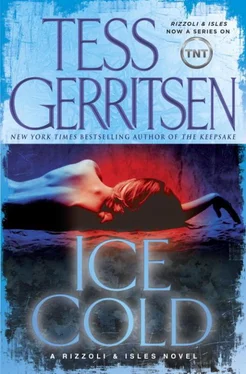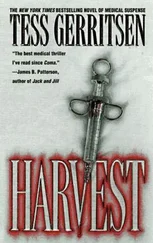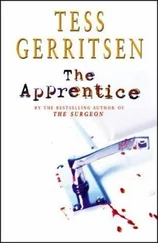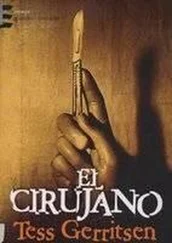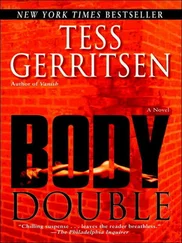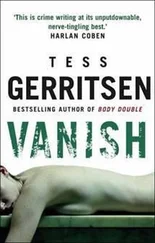She nodded to Jane, and they left the ICU.
When they arrived in the morgue, they found the anteroom crowded with observers, Sheriff Fahey and Detective Pasternak among them. The sheer number of victims had made this a high-profile case, and nearly a dozen law enforcement and state and county officials had gathered to witness the autopsy.
The pathologist saw Maura walk into the room and raised a beefy hand in greeting. Two summers ago, she’d met Dr. Fred Gruber at a forensic pathology conference in Maine, and he seemed pleased to spot a familiar face.
“Dr. Isles,” he called out in his booming voice. “I could use another set of expert eyes. You want to gown up and join me in there?”
“I don’t think that’s appropriate,” said Sheriff Fahey.
“Dr. Isles is a forensic pathologist.”
“She doesn’t work for the state of Wyoming. This case is going to be watched closely, and questions could be raised.”
“Why would there be any questions?”
“Because she was in that valley. She’s a witness, and there could be charges of tampering. Contamination.”
Maura said, “I’m only here to observe, and I can do that perfectly well from this side of the window, with the rest of you. I assume we can watch it on that monitor?” She pointed to the TV screen mounted in the anteroom.
“I’ll turn on the camera, so you’ll all have a good view,” said Dr. Gruber. “And I’m going to ask all the observers to remain in this room anyway, with the door shut. Since there’s a possibility we’re dealing with cyanide poisoning.”
“I thought you had to swallow the stuff to get sick,” one of the officials said.
“There’s the chance of outgassing. The biggest danger is when I cut into the stomach, because that’s when cyanide gas might be released. My assistant and I will be wearing respirators, and I’ll dissect the stomach under the fume hood cabinet. We’ve also brought a GasBadge sensor, which will immediately alert us if it detects hydrogen cyanide. If it’s negative, I may be able to let some of you into the room. But you’ll have to wear gowns and masks.”
Gruber donned dissection garb, including a respirator hood, and pushed through the door into the autopsy lab. His assistant was already waiting, similarly garbed. They turned on the camera, and on the TV monitor, Maura could see the empty autopsy table awaiting its subject. Gruber and his assistant wheeled the plastic-shrouded body out of cold storage and slid it onto the table.
Gruber unzipped the shroud.
On the video monitor, Maura could see that the body was a young girl, only about twelve or thirteen. Since the exhumation from the frozen ground, her flesh had been allowed to thaw. Her face was ghostly pale, her blond hair a crown of damp ringlets. Gruber and his assistant were quietly respectful as they removed the garments. Off came a long cotton dress, a knee-length slip, and modest white briefs. The corpse, now nude, was slender as a dancer’s, and despite days of burial, she was still eerily beautiful, her flesh preserved by the valley’s subfreezing temperatures.
The officials pressed in closer around the monitor. As Gruber collected blood, urine, and vitreous specimens for toxicology, the men’s eyes took in what should never have been revealed to them. It was a violation of a young girl’s modesty.
“The skin is markedly pale,” they heard Gruber say over the intercom speaker. “I see absolutely no residual flush.”
“Is that significant?” Detective Pasternak asked Maura.
“Cyanide poisoning can sometimes cause the skin to appear bright red,” she answered. “But this body has been frozen for days, so I don’t know if that would affect it.”
“What else would you find in cyanide poisoning?”
“If it’s ingested orally, it can corrode the mouth and lips. You’ll see it in the mucous membranes.”
Gruber had already slipped a gloved finger into the oral cavity and he peered inside. “Membranes are dry, but otherwise unremarkable.” He glanced through the window at his audience. “You getting a good view of this on the monitor?”
Maura nodded at him. “There are no corrosive lesions?” she asked over the intercom.
“None.”
Jane said, “Isn’t cyanide supposed to smell like bitter almonds?”
“They’re wearing respirators,” said Maura. “They wouldn’t be able to smell it.”
Gruber carved the Y-incision and picked up the bone cutters. Over the intercom, they heard the crack, crack as he split the ribs, and Maura noticed several of the officials suddenly turn away and stare at the wall. Gruber lifted up the shield of sternum and ribs, exposing the chest cavity, and reached into the chest to resect the lungs. He lifted out one wet and dripping lobe. “Feels pretty heavy to me. And I’m seeing some pink froth here.” He sliced into the organ, and fluid oozed out.
“Pulmonary edema,” said Maura.
“What does that signify?” Pasternak asked her.
“It’s a nonspecific finding, but it can be caused by a number of drugs and toxins.”
As Gruber weighed the heart and lungs, the camera remained fixed on a static view of the torso, gaping open. No longer were they staring at a nubile young girl. What once might have titillated had been transformed to butchered flesh, a mere carcass of cold meat.
Gruber once again picked up his knife and his gloved hands reappeared on the monitor. “This damn face shield keeps fogging up,” he complained. “I’ll dissect the heart and lungs later. Right now, I’m most concerned about what we’re going to find in the stomach.”
“What is your sensor showing?” Maura asked.
The assistant glanced at the GasBadge monitor. “It’s not registering anything. No cyanide detected yet.”
Gruber said, “Okay, here’s where things could get interesting.” He looked through the window at his audience. “Because we could be dealing with cyanide, I’m going to proceed a little differently. Normally I’d just resect, weigh, and open up the abdominal organs. But this time I’m going to clamp off the stomach first, before I resect it in toto.”
“He’ll place it under the fume hood before he slices it open,” Maura explained to Jane. “Just to be safe.”
“Is it really that dangerous?”
“When cyanide salts are exposed to gastric acid, they can form toxic gas. Open that stomach and you release the gas into the air. That’s why they’re wearing respirator hoods. And why he’s not going to cut into that stomach until it’s under a fume hood.”
Through the window, they watched Gruber lift the clamped and resected stomach out of the abdomen. He carried it to the fume hood cabinet and glanced at his assistant.
“Anything showing up on the GasBadge?”
“Not a blip.”
“Okay. Bring that monitor closer. Let’s see what happens when I start cutting.” Gruber paused, staring down at the glistening organ, as though bracing for the consequence of what he was about to do. The fume hood blocked Maura’s view of the actual incision. What she saw was Gruber’s profile, his head craned forward, his shoulders hunched in concentration as he sliced. Abruptly he straightened and looked at his assistant.
“Well?”
“Nothing. It’s not reading cyanide, chlorine, or ammonia gas.”
Gruber turned to the window, his face obscured by the fogged mask. “There are no mucosal lesions, no corrosive changes in the stomach. I have to conclude that we’re probably not dealing with cyanide poisoning.”
“Then what killed her?” asked Pasternak.
“At this point, Detective, I’d be guessing. I suppose they could have ingested strychnine, but the body shows no lingering opisthotonos.”
“What?”
“Abnormal arching and rigidity of the back.”
Читать дальше
